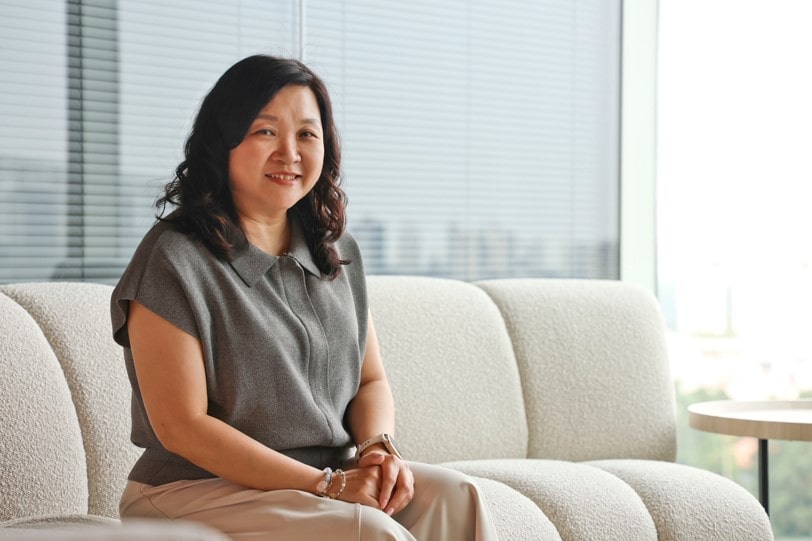
May Ong, director of HTX’s CBRNE (Chemical, Biological, Radiological, Nuclear, and Explosives) Centre of Expertise (CoE). (Photo: HTX)
This personality profile is part of a series of stories about Xponents who have been with HTX since the very beginning. Their contributions have been pivotal to the growth of the agency, which was founded on 1 December 2019.
Growing up, May Ong was so captivated by the cult classic action movie The Rock that she decided her career would be based on it.
But she didn’t aspire to be an actress or a film director. She wanted to be like the
character Dr. Stanley Goodspeed, an FBI chemical weapons specialist.
“To a chemistry buff like me, that seemed like a really cool job to have,” quipped May, who is today the director of HTX’s CBRNE (Chemical, Biological, Radiological, Nuclear, and Explosives) Centre of Expertise (CoE).
“And that was when I started researching where I
could find a job like that. The closest one I could find was a researcher at DSO National Laboratories, which I knew was associated with the Ministry of Defence. It sounded like a good bet.”
Serendipity came calling a few months later
when she landed the role after obtaining her diploma in chemical process technology. For more than a decade at DSO, she was given the opportunity to further her studies and do exactly what Dr. Stanley Goodspeed did.
In fact, she has
over the course of her career handled numerous kinds of dangerous materials, including bioterrorism agents like soman, sarin, as well as the very same nerve agent that was featured in The Rock – VX, which can cause death in just minutes.
Getting hands-on
It wouldn’t be accurate to say that May always aced her science lessons.
“I actually failed science when I was in Primary 3,” she laughed. “I just wasn’t
very interested in learning about it because I felt whatever was taught was too general and we weren’t given explanations as to why a reaction would happen the way it did.”
But things changed for the better in secondary school,
courtesy of passionate teachers who took great lengths to make science lessons engaging and interesting. Chemistry was a subject May was particularly fond of because she enjoyed learning about different types of chemical reactions. So curious was
she that she even carried out experiments at home.
For example, she had on many occasions scrummaged the drawers and cabinets in the kitchen for medication that she would crush and mix with different liquids to see if any chemical reactions
took place. She also tried to determine if eye drops did indeed contain saline or were just fraudulent products containing only water – by tasting them.
Once, after reading a book that detailed how the German troops used chlorine
gas against Allied forces, May cooped herself in a toilet with bottles containing bleach and stain remover. Upon mixing the two chemicals in a pail, yellow chlorine gas started manifesting. As did a combination of shock and elation.
“I
quickly opened all the windows and tried to ventilate the area. I still remember my mum exclaiming about the pungent odour that was wafting through the house and wondering what on earth was going on,” she chuckled.
Given her proclivity
for chemistry, May went on to study chemical process technology in polytechnic. But unlike most of her peers who were gunning for lucrative positions in petrochemical companies after graduation, May had only one goal in mind – to follow her
heart and do what she wanted to do. And this was why she accepted the research role at DSO National Laboratories.
“I just wasn’t interested in using my knowledge to help companies make the bottom line,” she explained.
“I wanted to do more extraordinary and exciting stuff that would make society better. I don’t think my head was turned even after my peers were telling me that they were getting massive bonuses ranging from six to eight months!”
Making the dream come true
During her time at DSO National Laboratories, May spent most of her time working on detoxification, which involved formulating decontamination methods and solutions to neutralise chemical
and biological weapons. Part of the job involved mass cultivating bacteria in 10-litre fermenters and attaching them to explosives that were set off in an enclosed and controlled environment so that researchers could conduct post-blast investigations
to understand their dispersion properties and ability to germinate in the environment.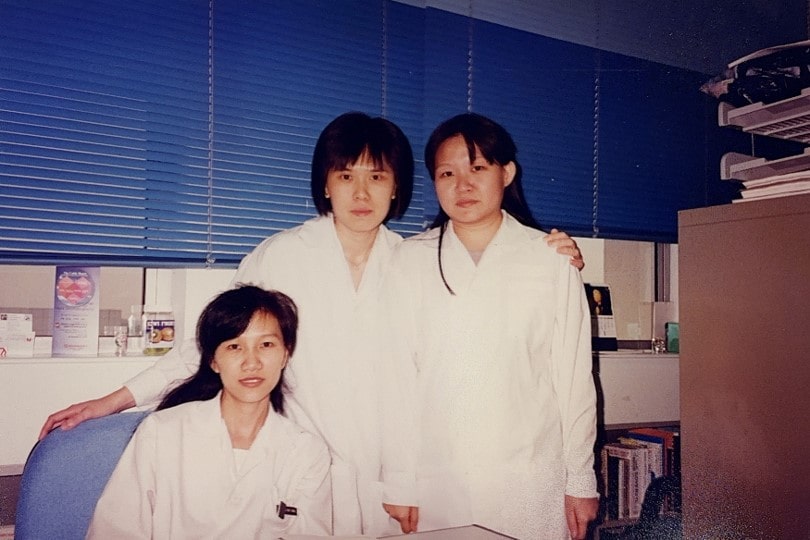
May (right) with her DSO colleagues. (Photo: May Ong)
The plucky lady hardly found the job to be unnerving. In fact, there were times when she even got a good laugh
out of it.
“I remember there was this one experiment we were conducting with MINDEF. Following the blast with sporulating substances, some of the military personnel started asking me a barrage of questions relating to the trial, but
I refused to speak a word. Naturally, they got a little annoyed and went to talk to my boss, who ended up entertaining their questions instead. The next morning, all of them suffered from diarrhoea,” she recalled.
“But I was
fine. Why? Because I had learnt through culturing the bacteria that movements of the face caused by talking too much can compromise the integrity of the seal the gas mask has with the face. This means you end up breathing in a few bacteria spores
that will germinate and produce toxin in the stomach!”
Another notable project May played a role in had to do with water purification solutions for the military. The solutions included special drinking straws that could filter water
and purification machines that could purify large volumes of water for troops.
In 2006, May decided to embark on a new challenge with the Ministry of Education, where she worked as a consultant for the Institute of Technical Education (ITE)
and provided advice to lecturers on chemistry-related matters. Much of the job also required her to strike up new partnerships between the school and industry players.
“I’ve always enjoyed bringing people with similar
mindsets together because collaboration is what makes things happen. Also, there’s always something new that we can learn from others,” she explained.
This love for playing matchmaker hasn’t waned. On 3 Oct 2024, May organised
a seminar on CBRNE threats and countermeasures that was attended by more than 80 experts from Singapore government agencies and HTX’s industry and academic partners. Among the big names involved was Dr Christina Baxter, who once served as the
CBRNE programme manager at the US Department of Defence.
She also relished interacting with the youth and is proud that a few of her students had gone on to complete their doctorates and even become a part of the CBRNE community. Today,
she continues to educate young minds as a part-time lecturer at the National University of Singapore.
But though she was enjoying her time at ITE, May couldn’t fight the urge to do something that would directly impact the safety of
the nation. Fortuitously, a friend who was working at the Ministry of Home Affairs (MHA) asked if she would be interested in working as a scientist in the new lab that the Immigration and Checkpoints Authority (ICA) would be setting up with MHA.
It was an offer she found difficult to resist.
Empowering homeland security
In her new role at MHA, May helped conduct chemical and bio surveillance operations at Singapore’s borders, ensuring that
CBRNE threats did not make their way into the country. For example, she and her colleagues would screen lorries carrying livestock for traces of avian influenza and help determine if heavy vehicles were indeed carrying the same chemicals that were
declared.
“I still remember spotting several trucks that were leaking chemicals, and we had to tell the drivers to alert their companies of the problem. The next time these drivers came around, I was stoked that the leaks were plugged.
I found it very gratifying that something as simple as providing feedback could go a long way to ensuring the safety of the public,” she said.
Over the course of the next decade, May steadily rose the ranks in MHA and expanded
its CBRNE analysis capabilities. She also got to expand her repertoire to include explosives detection and DNA profiling, both of which she cited as among her most memorable experiences at the ministry.
In 2019, May joined the newly formed
HTX as director of the CBRNE CoE. That same year in November, when she was on holiday, she caught wind of a new disease rampaging through China from her friends at the Centers for Disease Control (CDC) in Japan.
In early January 2020,
when scientists around the world started learning about the genome sequence of Covid-19, May knew she had to take preemptive action and reached out to her contacts with the aim of developing a diagnostic kit that could detect the new virus at the
borders.
On 5 March 2020, the kit developed by HTX’s CBRNE CoE and its industry partner Veredus Laboratories was deployed across land, air and sea checkpoints. But the CBRNE team had little time to rejoice in this achievement as they
were swarmed with Covid-19 samples that were coming from 12 checkpoints across the country shortly after.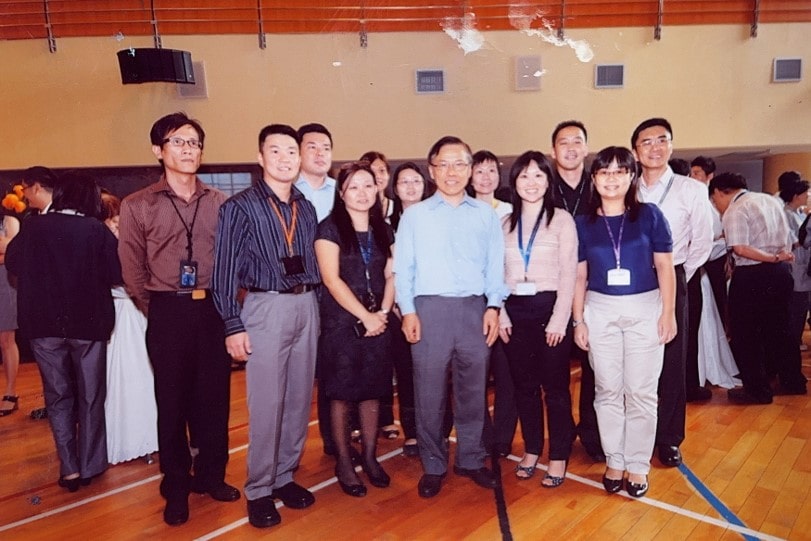
May (fourth from left) attending a function with her MHA colleagues. (Photo: May Ong)
“The lab in Pasir Panjang I was working at could only handle 300 samples
a day. During the height of the pandemic, we had to process a staggering 700 samples daily. The massive pile of samples never seemed to get smaller no matter how quickly we worked,” she recalled.
“I could tell that many
people were feeling down. There was seemingly no light at the end of the tunnel. For the sake of my team, I knew I had to do something to break this vicious cycle.”
Faced with this situation, May shut down two of the CBRNE labs operating
at the land border and had her colleagues transport the equipment to the Pasir Panjang facility. The move proved to be a masterstroke – her team managed to clear all the samples with the addition equipment.
Under May’s leadership,
the CBRNE CoE steadily increased its daily testing capacity over the following months with the use of automation and new equipment. By August, the team was able to test 2,000 samples a day.
The CBRNE team also contributed to national efforts
to assess the spread of the virus by working with a host of organisations, including the Public Utilities Board and the National Environment Agency, to conduct Covid-19 surveillance on wastewater.
“I remember we had colleagues from
the Q Team run cables from the labs to the conference room so that we could send the lab results out. We even had colleagues from human resources volunteer to transport human swab samples. Colleagues from the strategic comms division and the Vehicle
and Weapon Systems CoE also visited us with snack and cooling teas. These are all moments that the team and I remember fondly,” she reminisced.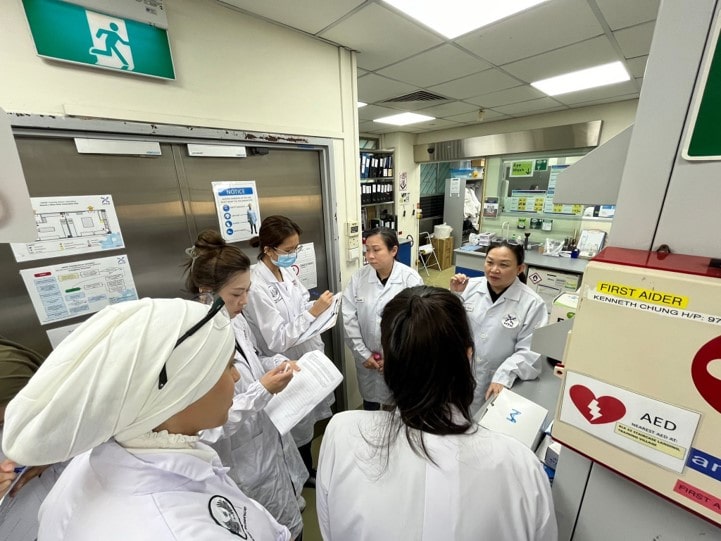
May (right) speaking to students at the HTX’s CBRNE Training School. (Photo: May Ong)
Looking ahead, May is determined to ramp up efforts to further augment
the Home Team’s CBRNE capabilities using cutting-edge tech.
“It’s now time to work on improving our CBRNE surveillance capabilities, which refer to not just reacting to threats but also proactively taking measures to prevent
them. It is imperative that we stay ahead of the curve. We cannot afford to be complacent,” she shared.
“One thing we will be doing is coming up with models to predict how factors like erratic weather conditions caused by climate
change can affect something like, say, the spread of a toxic chemical plume.”
Another goal she has is to groom competent scientists so that HTX can continue to deliver innovative and cutting-edge homeland security solutions for Singapore.
Finding zen
It may surprise many that this go-getter’s life away from the office could be described as the polar opposite of her career in the CBRNE realm.
“I go for Buddhism class every week.
I also do calligraphy because it helps me to relax and recalibrate,” shared May.
True to her hands-on nature, she also helps the temple she goes to repair old Buddhist scriptures. This painstaking and delicate process involves replacing
damaged pages and sections with special paper and rewriting many of the Chinese characters by hand.
To stay in shape, May goes for Zumba classes and leisurely walks at park connectors and beaches. She is also a gardening enthusiast who
boasts an impressive collection of some 70 potted plants, including a large collection of yellow, orange, red, pink and champagne roses, as well as succulents like the Cotyledon Tomentosa. She has even tried crossbreeding some of her roses to get
new varieties.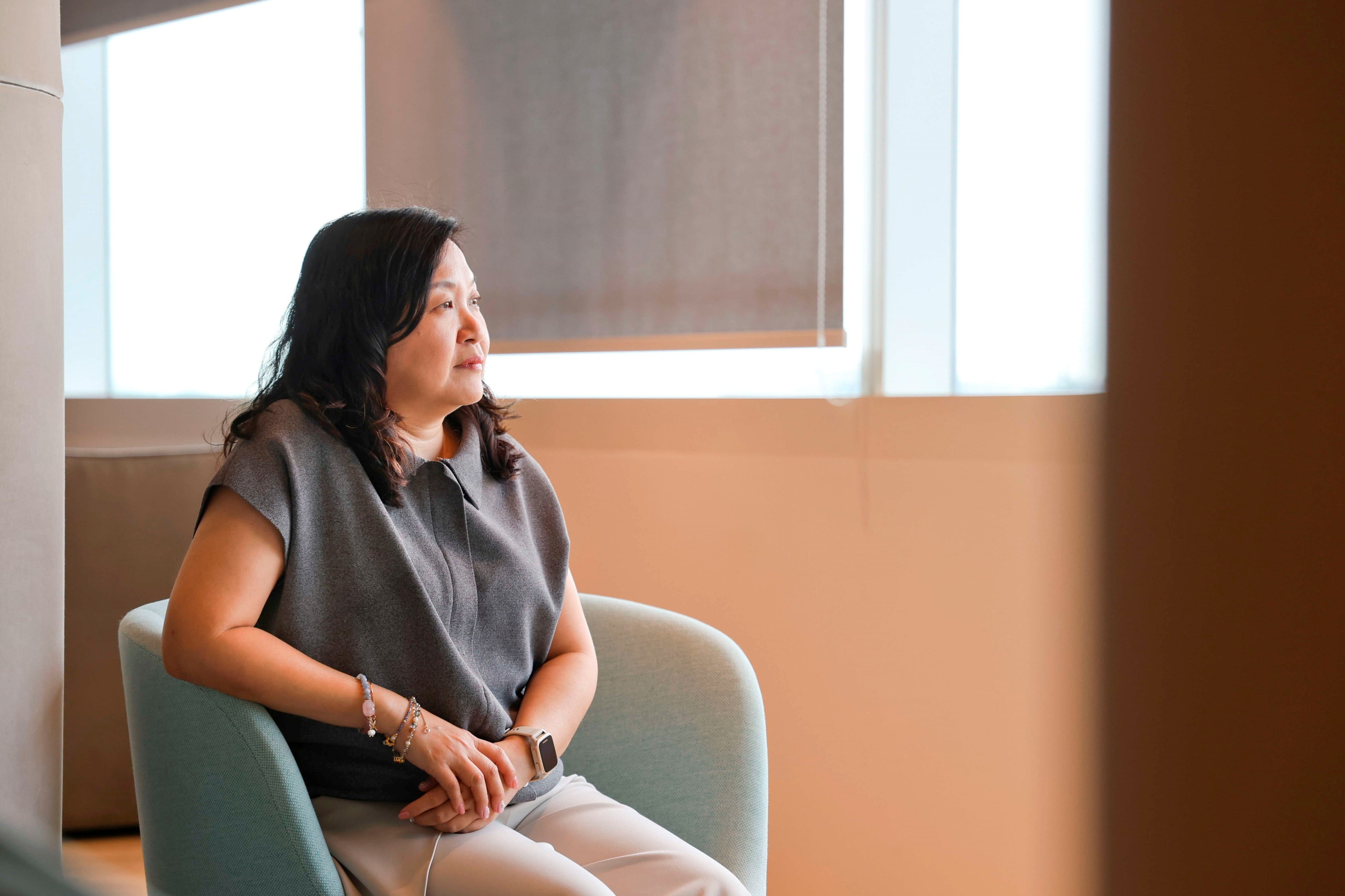
“I enjoy gardening because it teaches me patience. You cannot rush the plants to grow and bloom, it takes hard work and determination to understand and figure out the optimal conditions that each species of plants needs to thrive,” she said.
“I’ve also managed to find parallels between gardening and people management. Just like plants, humans too need care in the form of encouragement and the provision of opportunities if they are to grow their strengths and become
better at what they do.”
When asked whether she still conducts science experiments at home, May flashed a grin and laughed.
“I don’t have to do such things at home anymore,” she said.
“I
now have proper, hi-tech labs to do so!”
We are always seeking inquisitive and innovative individuals to co-create extraordinary solutions with us.
Join us to be at the forefront of the finest tech capabilities in the field! Join Us

